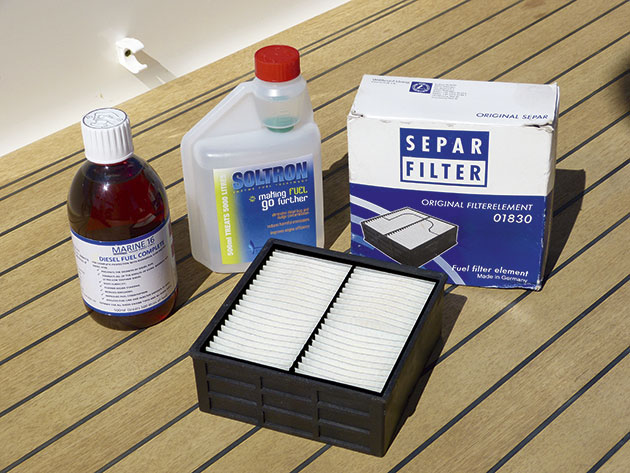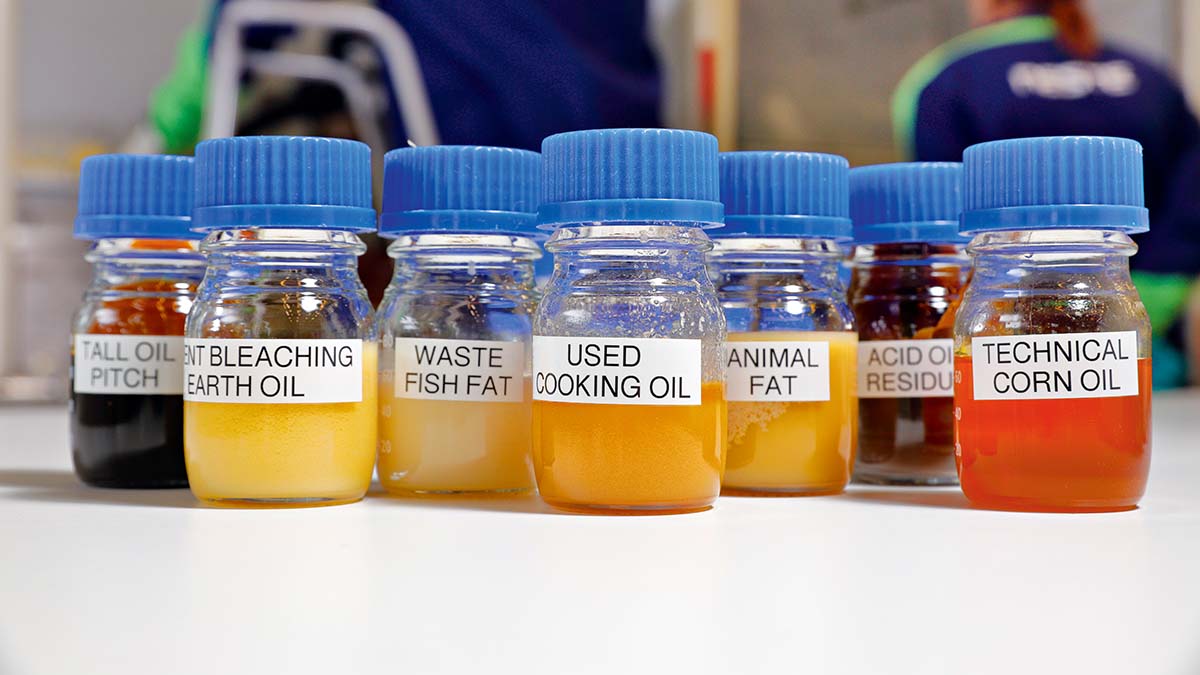A new generation of biofuel that is cleaner, greener, better for your engine and less prone to microbial growth than conventional fossil diesel sounds too good to be true but the facts about HVO beg to differ…
Biodiesel does not currently enjoy a good reputation among the boating community. Stories of blocked filters, diesel bug infestations, damaged fuel lines and corroded pistons have put boat owners off the very idea of using it.
However, a new generation of renewable diesel that is chemically identical to fossil-based diesel but cuts carbon dioxide emissions by 90% could prove to be the quickest and simplest route to a cleaner, greener boating future.
It sounds almost too good to be true and yet this fuel already exists and is currently in use in some cars, aeroplanes and even commercial boats.
So what is it, how is it made, how come it’s not yet readily available to leisure boat owners, and is it really the silver bullet we’ve all been waiting for? We’ve spoken to the experts at renewable fuel specialists Neste and engine builders Rolls-Royce MTU to bring you the answers.
What is HVO renewable diesel?
Hydrotreated Vegetable Oil (HVO) or Renewable Diesel are two of several terms used to describe a new generation of bio-based diesel that is much cleaner-burning and far less prone to problems than the first generation FAME (Fatty Acid Methyl Ester) biodiesel.
This new generation of renewable diesel is a clear, colourless, odourless liquid that is chemically almost identical to the main component in fossil-based mineral diesel. It has all the same key characteristics and none of the drawbacks of either mineral or FAME biodiesel.
In fact, it actually burns cleaner than fossil diesel because it lacks the naturally occurring impurities and aromatic hydrocarbons that give fossil-based diesel its distinctive colour and smell.
Other terms for this new type of fuel include HDRD (Hydrogenation Derived Renewable Diesel) and HBD (Hydro-generated biodiesel).
Article continues below…

Cleaner boating fuels: 5 diesel alternatives that could outperform batteries

VIDEO: How to… Prevent diesel bug
No owner wants plans to be cut short by diesel bug, Jon Mendez's video goes through how to prevent dreaded
Whatever the name, they all refer to the same end product, a renewable paraffinic diesel which has been treated with hydrogen in order to meet the European EN15940 standard for ‘Paraffinic Diesel Fuel from Hydrotreatment’.
How does HVO differ from first generation FAME ‘biodiesel’?
FAME (Fatty Acid Methyl Ester) is a relatively crude form of unrefined biodiesel made by mixing vegetable oil with methanol and sodium hydroxide to separate out the glycerol and leave behind a fuel that burns like diesel.
It’s quick and cheap to make but the end result is a very different chemical composition to mineral diesel. It still burns well enough but its chemical make-up contains up to 11% oxygen by weight.
It is this oxygen that causes many of the problems associated with biodiesel, as oxygen attracts water and encourages oxidation (corrosion).

Neste’s renewable HVO diesel (the flame on the left) burns cleaner than fossil diesel, as illustrated in this startling image
Over time this can lead to microbial growth, sludge, sooty deposits, clogged filters and a build up of acidity that can ultimately damage hoses, seals and even metal parts like pistons.
This isn’t usually a problem when mixed with mineral diesel in sufficiently small quantities (the B7 diesel found in most roadside fuel stations contains up to 7% FAME) and used quickly but when mixed in higher quantities or left languishing in fuel tanks for long periods, its limitations soon become clear.
Modern marine engines are fine to run on standard B7 road diesel (the maximum approved limit is usually around 20% FAME) but question marks hang over the risks of leaving a large quantity of B7 in your fuel tanks for longer periods of time, especially over winter, due to the increased risk of diesel bug.
What is renewable diesel made from?
Potentially, it can be made from a wide variety of different organic substances including vegetable oil, palm oil, soyabean oil, animal and fish fat, and used cooking oil among others.
In reality, used cooking oil is the greenest and least ethically problematic source. It also qualifies for the highest reduction in total carbon dioxide emissions (90%) because the oil has already been grown and used to cook food.

HVO can be made from a number of different feedstocks including used cooking oil and animal fat waste
Recycling it into renewable diesel is arguably the most efficient and sustainable way of disposing of it. Animal and fish fat may pose ethical issues for some but they are byproducts of the fishing and farming industry that would otherwise go to waste.
Unused vegetable oil grown purely for turning it into biodiesel is a perfectly valid source but may come in for criticism if it is produced at the expense of food or, in the case of some palm and soyabean oils, is seen to be contributing to global deforestation.
How is renewable diesel made?
Different companies use different processes to achieve the same result but the key difference is that the raw feedstock (usually the same vegetable or used cooking oil used to make FAME) is heated in the presence of hydrogen and passed over a catalyst – hence the term Hydrotreated Vegetable Oil (HVO).
This breaks the molecular chains, changing the chemical structure and causing the oxygen to combine with the hydrogen to create water (H2O) which is then easily removed from the fuel.
It’s a more costly and complex process than FAME production but the end result is a much cleaner fuel without the drawbacks of traditional biodiesel.
Why is it more environmentally friendly?
Because although it emits much the same quantity of carbon dioxide as mineral diesel when burnt (one of the primary causes of global warming), the plants which the vegetable oil was extracted from have absorbed that CO2 from the atmosphere.
Growing the next crop of maize, rape seed, or soyabean will reabsorb the same quantity of CO2 all over again. Mineral diesel on the other hand comes from fossilised organic matter, which until being extracted from the earth, has locked up that CO2 underground.
Burning it adds to the total amount of CO2 in the atmosphere, overpowering the planet’s ability to reabsorb it. Renewable diesel is still not considered to be 100% carbon neutral because the refining process itself requires energy and hydrogen, while the fuel itself has to be transported around the globe.
This wastage is calculated at around 10%, hence the reason it only qualifies for a maximum 90% reduction in CO2. Renewable diesel made from raw vegetable oil still qualifies for a 60% reduction in CO2 over fossil diesel, but not the full 90%.

What are the claimed benefits of HVO?
As well as being a nicer fuel to handle with no colour or smell in its raw state, it also burns more cleanly than either FAME or mineral diesel. This is due to three main reasons.
Firstly, renewable diesel has a higher cetane number of 70 compared to 51 for standard EN590 road diesel – the higher the cetane rating, the more complete the combustion process.
Secondly, it contains less sulphur (5mg/kg vs 10mg/kg), an impurity that causes noxious emissions when burnt.
And thirdly it contains no aromatics (0% vs 5%), the complex hydrocarbons present in fossil diesel that are responsible for many of the small particle emissions and harmful nitrous oxides.
Despite this, HVO has much the same lubricity and cold weather performance as road diesel, and a longer shelf life too (because of the 7% of FAME routinely added to B7 road diesel).
Are there any technical disadvantages of HVO?
Only one and even that’s debatable – it has a slightly lower density of around 780kg/m3 compared to around 830kg/m3 for road diesel, so it packs slightly less energy than the equivalent volume of fossil diesel.
In theory that should lead to a slight reduction in the power output of the engine it is burnt in but in practice this seems to be outweighed by its cleaner, more efficient combustion process.
Long-term tests carried out by Rolls-Royce MTU in a small passenger ferry showed no significant drop in power over fossil diesel. In 2021 Volvo Penta also switched to using HVO fuel in its Krossholmen test centre, racking up 5,000 hours of engine time, 40,000nm at sea and consuming 116,000 litres of HVO.

Most modern marine diesel engines are approved to run on HVO, including Volvo Pentas and MTUs
“The switch is as easy as simply fuelling with HVO 100 instead of diesel,” says Torbjörn Tössberg, head of the test centre. “We have not seen any reduction in performance or range”.
Diesel outboard engine manufacturer Cox also used HVO to set a new world speed record of 62.27mph for one of its 300hp CXO engines in November last year.
Is HVO approved for use in boat engines?
One of the big benefits of HVO over FAME biodiesel is that it can be used as a direct replacement for fossil diesel or mixed with it in any ratio from 1-100% without unduly affecting performance, longevity or reliability of the engine.
In some countries it is already possible to fill up your car or boat with 100% HVO from a dedicated pump – Neste Renewable Diesel is available at over 600 filling stations throughout Europe and in a handful of marinas in Sweden.
Most of the major marine engine builders have approved the use of EN15940 HVO in their current ranges. That said, please do check this applies to your specific make, model and warranty supplier before making the switch.

Who makes HVO?
Neste, Total, Shell and ENI all produce HVO in significant quantities along with dozens of other fuel producers around the globe. According to the International Energy Agency (IEA) 2021 Renewables report, global production of renewable diesel reached 14.5 billion litres in 2022.
To put that in perspective, the IEA estimates that the current global demand for diesel stands at over 1,642 billion litres per year. In other words renewable diesel currently accounts for less than 1% of global demand.
What does HVO cost?
That depends on where you buy it and whether there are any special tax allowances for renewable fuels in that country. It does cost more to produce than both fossil based diesel and FAME biodiesel, but the actual price consumers pay depends on the level of duty applied to it.

Neste’s refinery in the Netherlands is the world’s largest producer of HVO
Here in the UK, diesel used for propulsion is charged at the same rate of 57.95p per litre plus 20% VAT, regardless of whether it is red, white, or HVO. Of course, HVO can also be used for domestic purposes both in the home (as heating oil) and on board a boat (in generators etc).
In this instance, a rebate means that the level of duty equates to 11.14ppl plus 5% VAT and applies to both HVO and other forms of diesel.
Is HVO available in the UK?
While it is available from a number of domestic heating oil suppliers, albeit at a price premium of 10-15% over regular heating oil, it is not yet available from either road or dockside filling stations.
However, that is set to change thanks to a new piece of legislation called the Renewable Transport Fuels Obligation (RTFO). Any fuel suppliers delivering more than 450,000 litres per year must meet a minimum percentage of renewable fuels.

Any make and model of boat powered by modern diesel engines should be capable of running on HVO without any modifications
Those that do meet or exceed the required level are granted Renewable Transport Fuel Certificates (RTFCs) for each litre of pure biofuel sold.
In the case of HVO, a double certificate is issued as it is derived from waste. Suppliers that don’t meet their obligation are obliged to buy their certificates instead, at a price of 50p per litre.
This creates a market in RTFCs, which in theory reduces the cost of fuels such as HVO, as suppliers can sell their excess certificates and pass on the savings to customers.
That’s the theory, but it remains to be seen how effective this is in encouraging HVO use, especially in marinas where sales of fuel remain relatively low compared to roadside filling stations.

Is HVO the answer to global warming?
It’s not the whole answer as there simply isn’t the capacity to grow sufficient raw materials or produce enough HVO to satisfy the current demand for diesel, let alone other fuels such as petrol, coal or gas.
However, it can certainly play a meaningful role in reducing our reliance on fossil fuels and the amount of CO2 we pump into the atmosphere.
This is particularly true of privately owned leisure boats, which unlike car and truck engines cannot easily be replaced by electric motors due to the sheer size and weight of the batteries required to power a big boat over a meaningful distance.
The fact that HVO can be used as a direct replacement for fossil diesel, requires no engine modifications, has a shelf life of up to 20 years and reduces net CO2 output by 90% makes it ideal for use in motor boats. The sooner it can be made available in marinas, the better.
First published in the February 2023 issue of MBY.
If you enjoyed this…
Be first to all the latest boats, gadgets, cruising ideas, buying advice and readers’ adventures with a subscription to Motor Boat & Yachting. Available in both print and digital formats, our monthly magazine will be sent directly to your home or device at a substantial discount to the usual cover price. See our latest offers and save at least 30% off the cover price.









